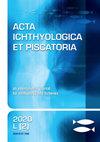A nitrogen factor for European pike-perch (Sander lucioperca), northern pike (Esox lucius), and sheatfish (Silurus glanis) fillets
IF 0.8
4区 农林科学
Q3 FISHERIES
引用次数: 1
Abstract
Measures for consumer protection against food adulteration and misleading labeling are integrated into EU legislation, including methods for detection of misleading practices. Verification of meat content is available for marine products but not for freshwater fish because of the lack of standard nitrogen factors. The aim of this study was to establish nitrogen factors for European pike-perch Sander lucioperca (Linnaeus, 1758), northern pike Esox lucius Linnaeus, 1758, and sheatfish Silurus glanis Linnaeus, 1758. The study involved analysis of 808 fillet samples obtained in spring (March–April) and autumn (October–November) harvest seasons, 2018–2019, from seven Czech Republic fish rearing facilities. Samples with and without skin were analyzed for nitrogen content, dry matter, protein, ash, and fat according to established ISO methods. The recommended nitrogen factor for European pike-perch with the skin is 3.28 ± 0.09 and without the skin is 3.21 ± 0.09; for northern pike with the skin is 3.18 ± 0.09 and without skin is 3.15 ± 0.09; and for sheatfish with skin is 2.73 ± 0.13 and without skin is 2.75 ± 0.12. The established nitrogen factors will enable analysis of meat content to ensure that consumers are purchasing correctly described and labeled fish products.欧洲梭鲈(Sander lucioperca),北方梭鱼(Esox lucius)和棘鱼(Silurus glanis)鱼片的氮因子
防止食品掺假和误导性标签的消费者保护措施被纳入欧盟立法,包括检测误导性做法的方法。对海产品的肉含量可进行核实,但对淡水鱼则不行,因为缺乏标准的氮因子。本研究的目的是建立欧洲梭鲈(Sander lucioperca, Linnaeus, 1758)、北方梭鲈(Esox lucius Linnaeus, 1758)和棘鱼(Silurus glanis Linnaeus, 1758)的氮因子。该研究涉及分析2018-2019年春季(3月至4月)和秋季(10月至11月)收获季节从捷克共和国七个养鱼设施获得的808份鱼片样本。根据已建立的ISO方法,分析带皮和不带皮的样品的氮含量、干物质、蛋白质、灰分和脂肪。带皮鲈鱼推荐氮因子为3.28±0.09,不带皮鲈鱼推荐氮因子为3.21±0.09;有皮梭子鱼为3.18±0.09,无皮梭子鱼为3.15±0.09;有皮的为2.73±0.13,无皮的为2.75±0.12。已建立的氮因子将使肉类含量的分析,以确保消费者购买正确描述和标签的鱼产品。
本文章由计算机程序翻译,如有差异,请以英文原文为准。
求助全文
约1分钟内获得全文
求助全文
来源期刊

Acta Ichthyologica Et Piscatoria
FISHERIES-ZOOLOGY
CiteScore
2.20
自引率
0.00%
发文量
31
审稿时长
>12 weeks
期刊介绍:
ACTA ICHTHYOLOGICA ET PISCATORIA (AIeP) is an international, peer-reviewed scientific journal that publishes articles based on original experimental data or experimental methods, or new analyses of already existing data, in any aspect of ichthyology and fisheries (fin-fish only).
 求助内容:
求助内容: 应助结果提醒方式:
应助结果提醒方式:


